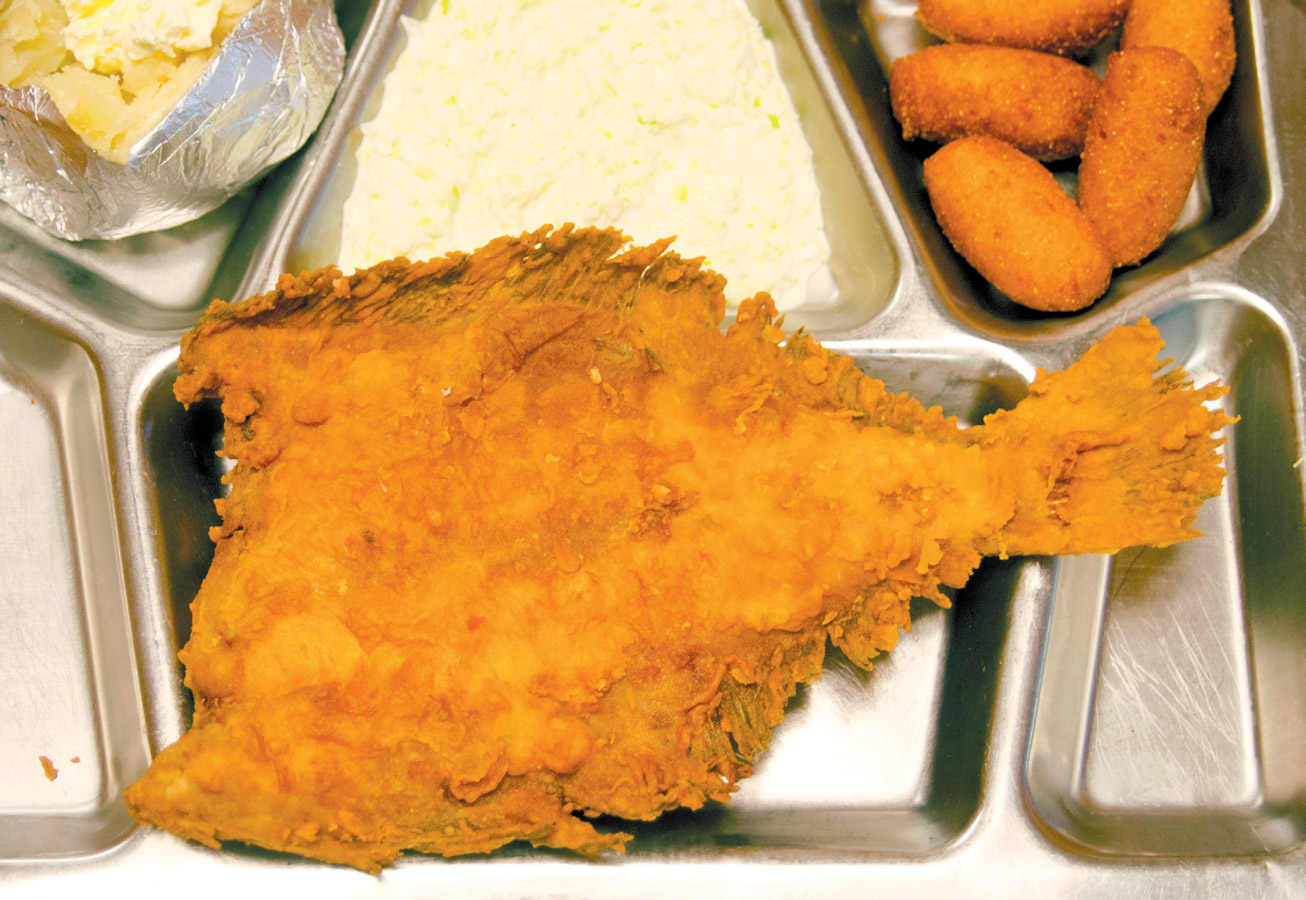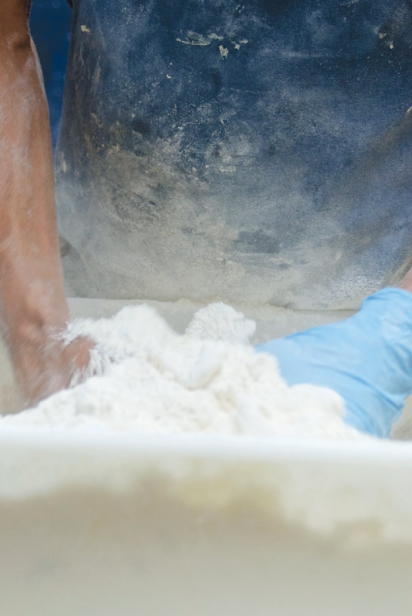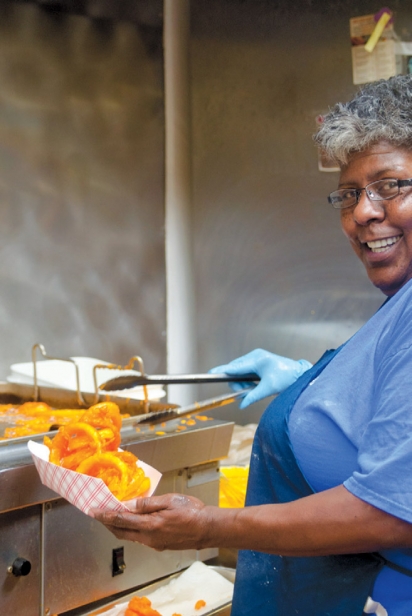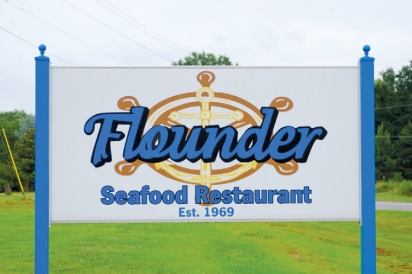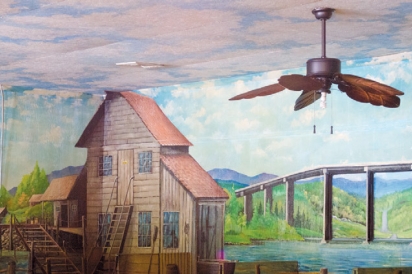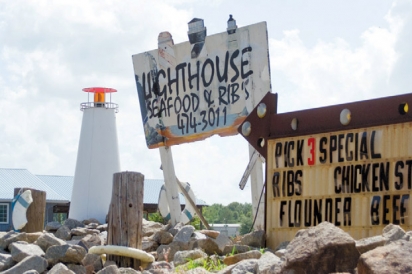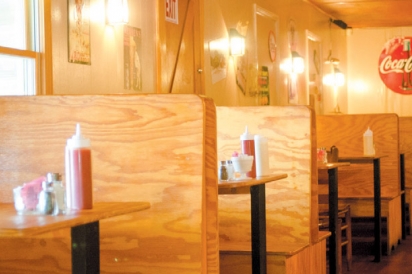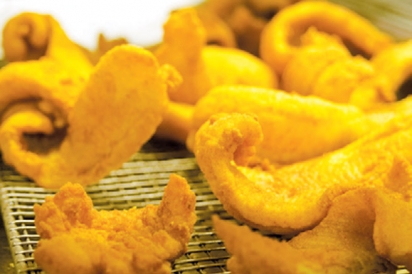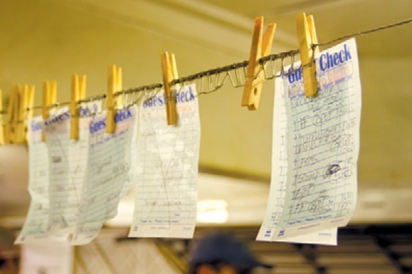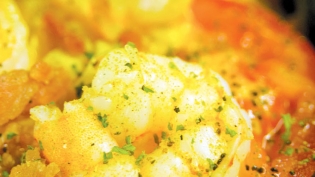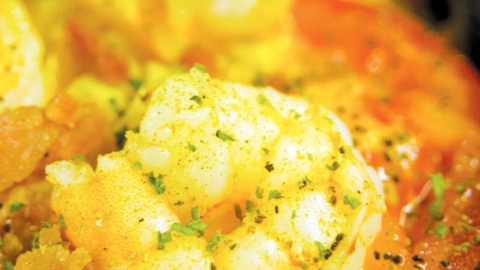Tradition on a Tray: The Story of Upstate Fish Camps
Although they’ve largely disappeared across the country, fish camps are still going strong in Spartanburg.
No, these are not spots to fish and eat what you’ve caught, build a fire and carouse a bit. Fish camps are fried seafood houses defined by their limited hours, restrained menus and earnest, generational vibe. Once a burgeoning dining concept, fish camps (or inland fish camps as they are sometimes called) are a bygone tradition lost to the American fabric except for here, in Spartanburg County, where a half dozen remain and a smattering more in nearby places.
Open just Thursday, Friday and Saturday from 4-9pm, it’s a business model that seems to defy logic, especially if you ask for a beer. No alcohol is served at a fish camp yet big parties file in week after week to sit at long, often industrial-style tables for fish and shrimp fried hot-toorder. It’s a numbers game, really, to get enough diners through the door during a 15-hour workweek. Tables of eight, twelve, even twenty are easily accommodated and dividing checks is no problem. It’s a place where extended families meet to spend time together.
Supper is fried flounder, catfish or shrimp plated with three sides (slaw, fries and hushpuppies) on a military issued aluminum tray. If the fish camp you’ve found doesn’t use metal slop trays, leave. They are perfectly sized for fish camp portions and separate smoking hot fried seafood from chopped chilly slaw. There are broiled options too and often pulled pork barbeque, chicken fingers, steak and baked potatoes—but the reason to seek out a fish camp remains the fried seafood.
Many who frequent fish camps believe their origins are tied to Camp Croft, a WWII Army Replacement Training Center (RTC) that once occupied 17,000 acres in Spartanburg County. In the spring of 1941, around 70,000 troops began to arrive each month. This continued for five years and likely most of them ate, at least once, at an alleged restaurant, more of a fry shack with folding tables positioned under shade trees.
As the opportunity grew to feed not only troops but also the thousands of civilian contractors employed to construct the base, so-called “fish camp” restaurants popped up serving fresh plates at affordable prices. Spartanburg had always been a fry town; churches and community centers, neighborhoods and liquor houses hosted fish fries on Fridays or Saturdays. And it was simple to acquire the quantity of fish needed; local business Sellers Seafood had supplied restaurants and individuals alike since the 1930s. To this day Sellers sells fish sourced from the Carolinas at its market on Henry Street.
Many of the young soldiers were new to the south and regionalized tastes began to influence the varieties of fish fried. Catfish (often fried whole) became a staple as well as whiting, cod and perch. Chicken bog and hash served over rice also made its way onto fish camp menus. French fries began to appear in earnest in the 1950s with the advent of delivered frozen foods.
Fish camps flourished in the post-war economy. Stay-at-home moms helped support growing families by waiting tables at fish camps three evenings a week. Teenagers were hired to “run trays” and bus tables, often as their very first job. It became a rite of passage to work at the local fry house and not uncommon for three generations of a family to work at the local fish camp. Teenagers were cheap, hardworking labor, but they couldn’t serve alcohol. This more than anything else kept the more successful fish camps from adding bar service.
It’s a throwback experience to visit a fish camp. Each fish camp I walked into felt like a homecoming and though I assumed I would have a favorite after researching this story, I didn’t. I loved them all. They are family places within tight knit communities. Repeatedly, owners and employees referred to each other frankly as “family” and the fish camp as their “second home.” Servers are regularly invited to weddings and are often one of the firsts to hold a new baby. Most of the dining rooms seat around 200 guests and though there may be a wait on a Friday or Saturday night, usually if someone is waiting it’s for their server at their table.
The decline of fish camps occurred slowly and for different reasons. One of the iconic fish camps, The Pioneer, burned down. A few transitioned to full service restaurants (none of them successfully); others struggled with aging buildings coupled with the rising cost of food and advertising. Many watched as the young people in their communities migrated to city centers away from townships. By the turn of the century, two-thirds of the once packed out fish camps were gone.
Those that remained survived by adapting to changing times. Menu items were added; salmon made its first appearance on fish camp menus as well as salads. Owners focused on quality, quietly raising prices, and moved away from peanut oil with its lower burn point and perceived allergy concerns. Biofuel companies showed up wanting to buy spent oil. The fish camps I visited pump oil either daily or biweekly into exterior holding tanks directly from their kitchens. The plan, if you talked to fish camp owners post Y2K, was to “hang on” in hopes of staying open for maybe another five years or so.
None saw what came next: fish camps became relevant once again. Two things happened to create a resurgence of the fish camp experience. The 2008 recession ushered in a culinary nostalgia of epic proportions: burgers, wood-fired pizza and family dining soared in contrast to fine dining. Staying close to home fit the bill and consumers rediscovered homegrown concepts like the fish camp.
The other thing had occurred decades before, put in motion unknowingly by fish camp proprietors. By 2012, many of the kids who had worked in fish camps back in the day had grown up to become food tourists (defined as those willing to drive up to 100 miles for a inimitable meal). A smartphone could get you to an obscure location lickety-split and social media had become an edible diary.
These patrons yearned for authentic dining experiences and would share notable ones with their friends and acquaintances online and by word-of mouth. The fish camps were waiting to welcome them in, living up to expectations because their antiquated concept would intrinsically work in their favor: fry it upon order, the same way every time, over and over, so it’s always good, always satisfying, and always exactly what you want.
The Flounder
Considered the oldest single-family run fish camp, The Flounder is a Spartanburg institution and is located closest to the city.
Arthur Toney built The Flounder when he retired from the Air Force in 1969 and it suited him just fine to run the fish camp part-time alongside his wife, Joann. The building burnt down in 1981 and was immediately rebuilt, though its military issue metal trays were lost. Arthur and his son, Ken, replaced nearly 400 of them by driving to Army/Navy Surplus stores in three states. They had exact plastic replicas made to replace the rest, which they only serve a “half plate” on.
Arthur famously handed over the keys to Ken in 1988, claiming he was tired of counting money. To this day The Flounder uses just a register and a couple of adding machines, though after much debate they agreed to take credit cards in 2002. Ken started working at the fish camp when he was 15 and met his wife, Pam, in the dining room five years later. She was a server and he was bussing tables that summer.
Their two sons, Lee and Clint, work at The Flounder. “One of my sons cooks and one runs the line,” says Ken, “and my brother Arty is a manager. At least a third of our staff is related to us and if they’re not they feel just like family anyway. We have a cook that’s been with us 30 years and a couple servers that have been here 40.”
Ken is quick with numbers, knows inherently how much fish to order (usually around 1000 pounds per week), and once figured out they sold 43 million hushpuppies. He’s proud of the quality of their foodstuff including full-size sea scallops, Heinz Ketchup and a machine that can chop a 50-pound bag of white cabbage in 10 seconds. It takes longer to clean the machine.
They go through 2,000 pounds of what Ken calls “shortening” each business day. It’s vegetable oil and they made the change from peanut oil in 1989. “It’s so clean that early in the day it’s sometimes hard to get things to brown up enough.”
The Flounder only closes on Thanksgiving, Christmas Eve, Christmas Day and the Fourth of July if it falls on a Thursday, Friday or Saturday. They credit Yelp and Facebook for driving out-of-town diners to their location. “We have a 4.7 star rating and a 95% return rate. We’re a good habit to have. Like clockwork the same folks will be here at the same time next week.” Don’t pass up the chance to try the phenomenal onion rings. The recipe is Ken’s grandmother’s; they are nearly orange from a bit of food coloring, a throwback from another era. They are massive orbs with a donut-like batter that is both savory and sweet, an ideal starter before perfectly fried fish and slaw arrive.
They run nine fryers in the kitchen: one for hush puppies and onion rings, one for shellfish, one for oysters, three huge deep fryers for “filets” and separate fryers for whole fish (one dedicated only to flounder). Six stews and excellent deviled crabs are made in-house.
“We really care about quality and we pay our employees well,” says Ken. “Back in the day fish camps would compete against each other, but those days are gone. We’re just glad those of us are still around.”
The Lighthouse
Leland McKelvey remembers opening night at The Lighthouse in 1973. “There was only one person who had ever worked in a fish camp and that was our cook, Evelyn Painer.”
They had hired Painer from The Pioneer Fish Camp and had decided to open The Lighthouse after a long wait at the other restaurant. “By 5:30pm we had 300 people waiting for either food or a table,” he says. “I decided right then and there to leave the hostess stand and get in the kitchen and I never left.”
Leland’s parents later opened Lake Bowen Fish Camp handing the reigns over to him in 1980. He’s taken two sick days in 37 years as proprietor.
The Lighthouse is in Pacolet, a town about ten miles outside the City of Spartanburg. Leland is 65 and has lived here since he was “eight about to turn nine.” He favors a thin fluffy batter on fried fish and is always tinkering with the recipe. “Right now I’m running a Louisiana-style batter. It’s really thin and crusty so it doesn’t absorb any grease. And, it has a little bite to it.”
Plates are served on the iconic military issued divided trays, which he has never had to replace, not even one. He says they come out of the sterilizer so hot they literally steam.
Though filet and shrimp are his best selling order, he favors whole fried catfish. “It’s like a T-bone steak. The bone flavors the meat.”
Chicken stew sells well in the winter alongside fried seafood; he’ll sell 60 gallons in a three-day workweek. Winter is his busiest season with the fascinating reason that “people like to eat when it’s dark outside.”
What sets The Lighthouse apart are its murals; they cover nearly every surface of the dining room. The artist is Clive Haymnes. It took him two and a half years to paint the dining room surfaces and the two private rooms at The Lighthouse. Every wall depicts a different beach from all over the world. Leland checked out books from the Pacolet Library, five at a time, for Haymnes to copy. Some notable work is on the center waitress stand depicting scenes of Pacolet in 1927 including the mill and the original schoolhouse.
There are five optical illusions built into the murals and 168 hidden things in their images. Leland also installed a model train around the perimeter of the dining room. He hoped it would help keep children content while waiting for food. “It fascinates even me,” he says, “and if it’s not turned on, they’ll come get me.”
Leland believes the difference between a fish camp and a seafood restaurant is the price; the same $11 meal at a fish camp will be $28 or more on the coast. “Last I checked there were 3600 restaurants in Spartanburg County. Basically my prices run from $8-15. I’ve never had anyone say they didn’t get full. We cook your food when you get here because until you’re here, I don’t know what you want. It’s that simple.”
Wagon Wheel
When you grow up in a family that runs restaurants, it seeps into what you know. Christine Perry felt that way; her family owned the Red Rooster and her uncles had been at the helm of the Bantam Chefs. “I always said I was in the restaurant business in the womb.”
She had been teaching elementary school for six years when her parents mentioned that the historic Wagon Wheel Fish Camp was for sale. She and her husband Christian quickly made an offer to purchase the crumbling restaurant with its aging clientele and never looked back.
The Wagon Wheel is the oldest operating fish camp in Spartanburg County. It opened in 1959 on Wagon Wheel Road in Cowpens, though it’s had four different owners. The Perrys were high school sweethearts and the hours of a fish camp appealed to the young couple hoping to expand their family. Christian was a homebuilder, so renovating the building and the grounds of the Wagon Wheel felt like an extension of what he was already doing.
“It was a failing restaurant. There was no doubt it was going under,” says Christian. “It was rough to start, but as word got out we changed things, made improvements, listened to the folks coming in, worked on the dining room and expanded the menu to fit what everyone in a family would eat.”
They installed equipment to speed up their turnaround and stopped frying fish before it was ordered. They put a smoker out back and began offering both pulled pork barbeque and ribs. Christine worked on recipes for fresh southern side dishes: homemade mac and cheese, okra, grits, green beans, and delicious fried green tomatoes served with a chow-chow inspired chutney.
Everything is made from scratch at the Wagon Wheel down to each sauce, batter, dressing, dry rub and of course the hush puppy mix. This is one of the very last fish camps to bring the traditional basket of hushpuppies tableside.
Their fish is cooked “extra done” keeping it especially crispy. Flounder is the big seller along with catfish and perch and shrimp. They make vats of pickled onion every Wednesday, an old fish camp tradition offered to cleanse the palate, but you have to ask for it if you’re not a regular. Christine loves to eat fried oysters but Christian favors a steak with mac and cheese on the side. They’ve added pasta and even fish tacos to the menu to keep local families coming into the Wagon Wheel each week.
Their two daughters, Moriah and Hannah, grew up at the restaurant alongside their parents. Hannah is 18 and works in the front of the house, naturally putting people at ease with her outgoing manner. The family lives in Gaffney, South Carolina, about 20 minutes away from the restaurant. The Perrys say the restaurant turned a corner when people outside of Cowpens rediscovered them, especially young families from the eastside of Spartanburg, Gaffney, Union and Blacksburg.
They get a call every month or so wanting to know how to camp or fish on the property. Christine—in her unassuming way—explains that they’re not that type of fish camp but always suggests that the caller come and share a meal with them. “We want everyone interested in the Wagon Wheel to come see us. They’ll have a good meal and meet some wonderful people, that’s something we are certain of.”
Three Things To Know Before Ordering
1. "Filet” means flounder, so a “filet mixed tray” will be a hefty order of fried flounder filets alongside a pile of fried shrimp, fries, slaw and hushpuppies on a divided aluminum tray. If you want any other fish, filet or whole, you need to ask for it specifically.
2. It’s frowned upon to substitute a side. If you’re in the mood for a baked potato or onion rings or a vegetable of some sort, it’s better to order it in addition to your plate.
3. “Half Orders” - You can order a half tray but it will be plated on a different dish, maybe a plastic tray or a diner plate and the dining room will take note. This is a total amateur move; it’s much better to leave with a to-go box than miss out on the opportunity to eat from a surplus tray.
The Fish Camps of Spartanburg County
The Flounder
Opened in 1969
160 Barbado Ln., Spartanburg
W-Sa 3:30-9pm
TheFlounderFishCamp.com
864-576-3165
The Lighthous
Opened in 1973
5680 South Pine St., Pacolet
Th-F 4-9pm
On Facebook at: Lighthouse Pacolet SC
Wagon Wheel
Opened in 1952
115 Wagon Wheel Rd., Cowpens
Th 4-8:30pm
F and Sa 4-9pm
On Facebook: Wagon Wheel Fish Camp
864-463-6531
Lake Bowen
Opened in 1979
8580 Hwy 9, Inman
W–Su 4-9pm
Sa open at 3:30pm
Su Country Lunch 11am-2pm
Lakebowenfishcamp.com
864-592-2663
Tadpole
Opened in 1978
1300 East Wade Hampton Blvd., Greer
Th-Sa 3:30pm-9pm
Su Lunch 12:30-2:30pm
On Facebook at: Tadpole Fish Camp
864-877-6316
Roebuck
Opened in 1961
597 McAbee Rd., Roebuck
Th 4-8:30pm
F-Sa 4-9pm
Roebuckfishcamp.com
Cash or Checks Only
864-576-3542


